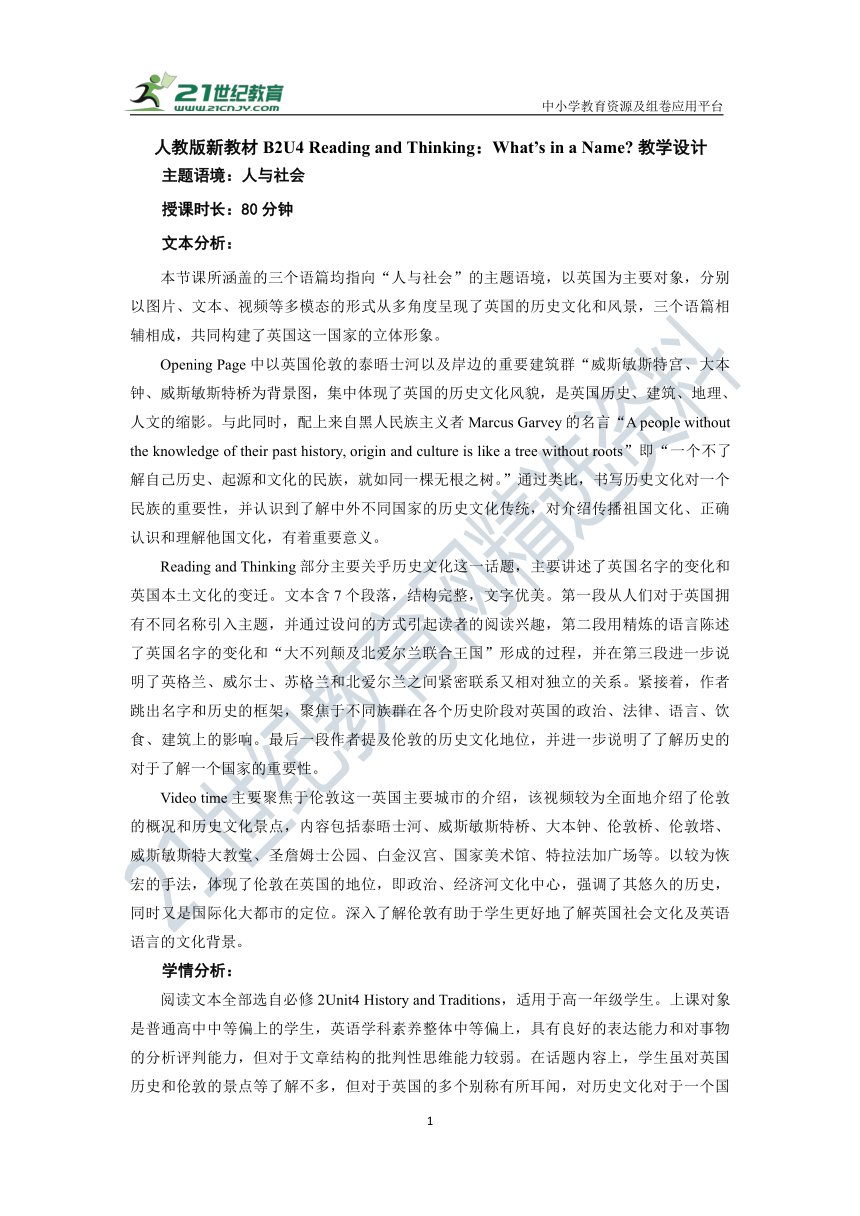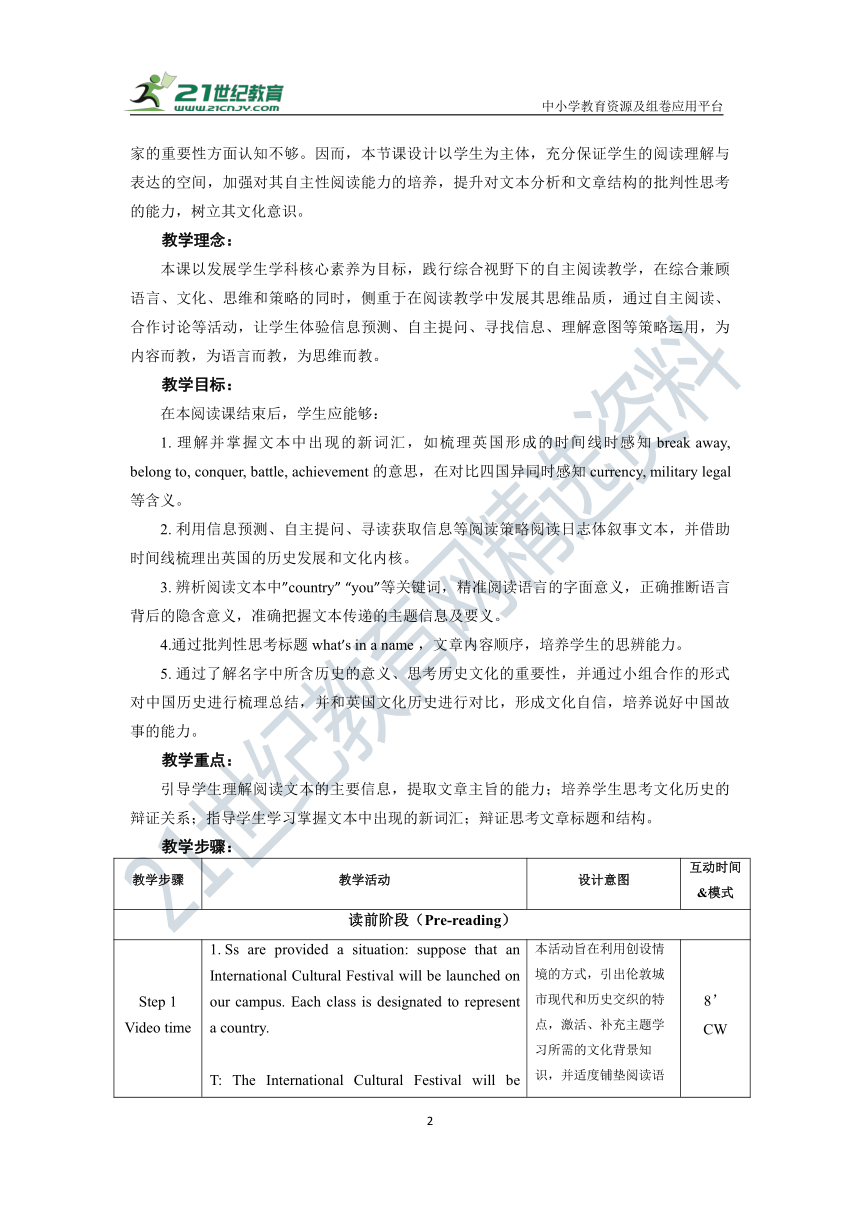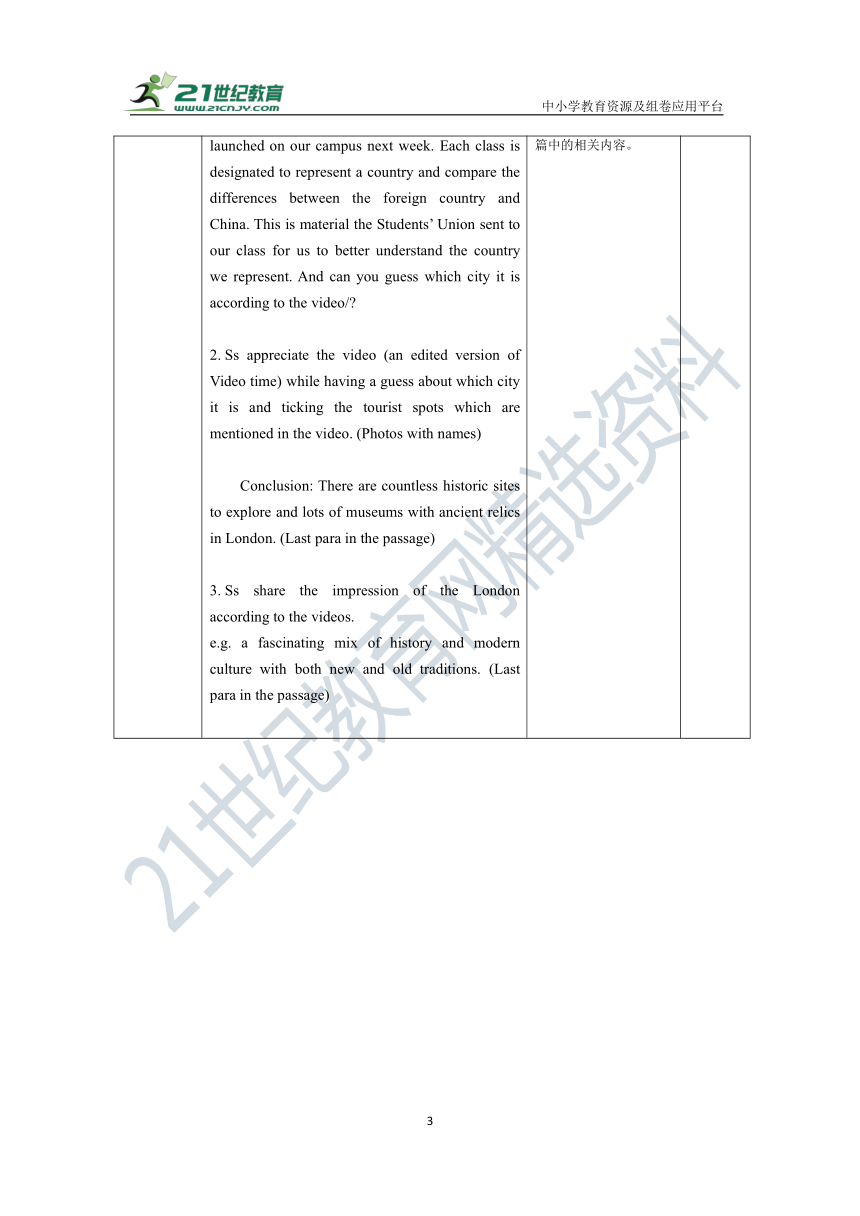人教版(2019)必修第二册 Unit 4 History and traditions Reading and Thinking 教学设计
文档属性
| 名称 | 人教版(2019)必修第二册 Unit 4 History and traditions Reading and Thinking 教学设计 |  | |
| 格式 | docx | ||
| 文件大小 | 2.4MB | ||
| 资源类型 | 试卷 | ||
| 版本资源 | 人教版(2019) | ||
| 科目 | 英语 | ||
| 更新时间 | 2024-09-20 20:12:41 | ||
图片预览




文档简介
中小学教育资源及组卷应用平台
人教版新教材B2U4 Reading and Thinking:What’s in a Name 教学设计
主题语境:人与社会
授课时长:80分钟
文本分析:
本节课所涵盖的三个语篇均指向“人与社会”的主题语境,以英国为主要对象,分别以图片、文本、视频等多模态的形式从多角度呈现了英国的历史文化和风景,三个语篇相辅相成,共同构建了英国这一国家的立体形象。
Opening Page中以英国伦敦的泰晤士河以及岸边的重要建筑群“威斯敏斯特宫、大本钟、威斯敏斯特桥为背景图,集中体现了英国的历史文化风貌,是英国历史、建筑、地理、人文的缩影。与此同时,配上来自黑人民族主义者Marcus Garvey的名言“A people without the knowledge of their past history, origin and culture is like a tree without roots”即“一个不了解自己历史、起源和文化的民族,就如同一棵无根之树。”通过类比,书写历史文化对一个民族的重要性,并认识到了解中外不同国家的历史文化传统,对介绍传播祖国文化、正确认识和理解他国文化,有着重要意义。
Reading and Thinking部分主要关乎历史文化这一话题,主要讲述了英国名字的变化和英国本土文化的变迁。文本含7个段落,结构完整,文字优美。第一段从人们对于英国拥有不同名称引入主题,并通过设问的方式引起读者的阅读兴趣,第二段用精炼的语言陈述了英国名字的变化和“大不列颠及北爱尔兰联合王国”形成的过程,并在第三段进一步说明了英格兰、威尔士、苏格兰和北爱尔兰之间紧密联系又相对独立的关系。紧接着,作者跳出名字和历史的框架,聚焦于不同族群在各个历史阶段对英国的政治、法律、语言、饮食、建筑上的影响。最后一段作者提及伦敦的历史文化地位,并进一步说明了了解历史的对于了解一个国家的重要性。
Video time主要聚焦于伦敦这一英国主要城市的介绍,该视频较为全面地介绍了伦敦的概况和历史文化景点,内容包括泰晤士河、威斯敏斯特桥、大本钟、伦敦桥、伦敦塔、威斯敏斯特大教堂、圣詹姆士公园、白金汉宫、国家美术馆、特拉法加广场等。以较为恢宏的手法,体现了伦敦在英国的地位,即政治、经济河文化中心,强调了其悠久的历史,同时又是国际化大都市的定位。深入了解伦敦有助于学生更好地了解英国社会文化及英语语言的文化背景。
学情分析:
阅读文本全部选自必修2Unit4 History and Traditions,适用于高一年级学生。上课对象是普通高中中等偏上的学生,英语学科素养整体中等偏上,具有良好的表达能力和对事物的分析评判能力,但对于文章结构的批判性思维能力较弱。在话题内容上,学生虽对英国历史和伦敦的景点等了解不多,但对于英国的多个别称有所耳闻,对历史文化对于一个国家的重要性方面认知不够。因而,本节课设计以学生为主体,充分保证学生的阅读理解与表达的空间,加强对其自主性阅读能力的培养,提升对文本分析和文章结构的批判性思考的能力,树立其文化意识。
教学理念:
本课以发展学生学科核心素养为目标,践行综合视野下的自主阅读教学,在综合兼顾语言、文化、思维和策略的同时,侧重于在阅读教学中发展其思维品质,通过自主阅读、合作讨论等活动,让学生体验信息预测、自主提问、寻找信息、理解意图等策略运用,为内容而教,为语言而教,为思维而教。
教学目标:
在本阅读课结束后,学生应能够:
1. 理解并掌握文本中出现的新词汇,如梳理英国形成的时间线时感知break away, belong to, conquer, battle, achievement 的意思,在对比四国异同时感知currency, military legal等含义。
2. 利用信息预测、自主提问、寻读获取信息等阅读策略阅读日志体叙事文本,并借助时间线梳理出英国的历史发展和文化内核。
3. 辨析阅读文本中”country” “you”等关键词,精准阅读语言的字面意义,正确推断语言背后的隐含意义,准确把握文本传递的主题信息及要义。
4.通过批判性思考标题what’s in a name ,文章内容顺序,培养学生的思辨能力。
5. 通过了解名字中所含历史的意义、思考历史文化的重要性,并通过小组合作的形式对中国历史进行梳理总结,并和英国文化历史进行对比,形成文化自信,培养说好中国故事的能力。
教学重点:
引导学生理解阅读文本的主要信息,提取文章主旨的能力;培养学生思考文化历史的辩证关系;指导学生学习掌握文本中出现的新词汇;辩证思考文章标题和结构。
教学步骤:
教学步骤 教学活动 设计意图 互动时间&模式
读前阶段(Pre-reading)
Step 1 Video time Ss are provided a situation: suppose that an International Cultural Festival will be launched on our campus. Each class is designated to represent a country. T: The International Cultural Festival will be launched on our campus next week. Each class is designated to represent a country and compare the differences between the foreign country and China. This is material the Students’ Union sent to our class for us to better understand the country we represent. And can you guess which city it is according to the video/ Ss appreciate the video (an edited version of Video time) while having a guess about which city it is and ticking the tourist spots which are mentioned in the video. (Photos with names) Conclusion: There are countless historic sites to explore and lots of museums with ancient relics in London. (Last para in the passage) Ss share the impression of the London according to the videos. e.g. a fascinating mix of history and modern culture with both new and old traditions. (Last para in the passage) 本活动旨在利用创设情境的方式,引出伦敦城市现代和历史交织的特点,激活、补充主题学习所需的文化背景知识,并适度铺垫阅读语篇中的相关内容。 8’ CW
Step 2 Prediction Ss are shown the map of the UK to find where London is and describe what the map demonstrates. T: Where is London Which country does London belong to S: the UK/Britain/England T: We also got a passage with a map from the Students’ Union. What can you find in the map of the UK S: Scotland….. Ss predict what will be talked about in the text according to the title and the map. What’s in a name What name are mentioned in the passage Why do they have so many names What’s the difference between these names What’s the relationship between these names When did they get those names What’s the difference and similarity between these four country (if raised then read para1-3) 通过描述教材上的地图加之以标题来对文中内容进行推测,为后续自主性阅读打下基础,启动主题思维,引导学生初步感知、注意文本的话题内容。 7’ CW IW
读时阶段(While-reading)
Step 3 Skimming & Detailed Reading (Para1-Para3) Ss read the text para1-2 briefly by themselves to find the answer to their question and make a timeline. What name are mentioned in the passage Why do they have so many names What’s the difference between these names What’s the relationship between these names When did they get these names Further question(if the last question is not raised by Ss) Paying attention to the word ”country” and Ss are given the definition of the country. Q: Why are Scotland..…called country Find the similarities and differences between four countries in Para 3. Q: Is it correct to use “ four countries” Ss find the answer for the primary question: Q:What’s in a name History of the UK 该活动旨在训练学生快速阅读全文以获取主要信息(Skimming for main idea)的阅读策略,解决先前进行的自主提问,并引导学生思考文章标题的“What’s in a name ”的答案。 12’ IW
Step 4 Detailed Reading (Para4-5) Ss have a second guess about what will be talked about in the following para(4&5). A: more history about the UK/ the importance of history. Ss complete the timeline and find the influence each groups of people brought to the culture of the UK. Ss draw a conclusion: What can show a country’s history and culture The language The architectures The name of the roads Legal system What’s beyond a name? The culture of the UK Why should we learn about the history of the UK (1) Studying the history of the country will make your visit much more enjoyable (2) The United Kingdom has a long and interesting history to explore which can help you understand much more about the country and its traditions 步骤1旨在完成Para1-3的阅读后,引导学生进行第二次阅读内容猜测,意在通过对Para1-3信息的获取梳理与解读后,培养学生体悟篇章结构和行文逻辑的能力。 步骤2旨在培养学生信息检索能力,并通过步骤3让学生自主总结归纳文化和历史在各个方面中的体现,并让学生进一步思考名字、文化、历史之间的关系以及了解历史文化的重要性。 12’ CW IW
Step 5 Thinking Ss focus on the sentence: If you keep your eyes open, you will be surprised to find that you can see both its past and present. Q1: Who does the word “you” refer to A: Visitors. Q2: What’s the main purpose of this text A: To introduce the fascinating history of the UK and attract people to visit the country. Ss ponder the structure and title: Q3: Can we put the para 4 before para 2 Is it better to strictly introduce the history in the order of the timeline Q4: Is “What’s in a name?” a good title 通过让学生聚焦代词“you”的用法,来推断出本文的写作目的——介绍历史。从写作目的出发,对文章的结构和文章标题进行批判性思考。 11’ CW IW
读后阶段(Post-reading)
Step 6 Project Ss are shown the map of the name of China and then analyze “What’s the name of China”. What’s in a name of China/Central State (Related to china/silk road Related to Chin Dynasty Related to the location of China Related to Khitan) Ss start to think about what is beyond the name of China as well. Q: What important thing should visitors know about before they come to China Ss work in a group of 6 make a poster about what’s in and beyond name of the UK and China. Situation: The International Cultural Festival will be launched on our campus next week. Each class is designated to represent a country and compare the differences between the foreign country and China. We have already learned something about the UK and have to make a poster about what’s in/beyond the name of both the UK and China now. Present some of the Ss’ posters and assess them according to the assessment standard. Content: Does it introduce what’s in and beyond the name of China and the UK (60 points) Language: Is the language concise and attractive (20 points) Grammar: Is there any grammatical mistake in the poster (10 points) Illustrations: Does the picture related to China and the UK (10 points) 步骤1补充中国名字相关的材料和地图,再次操练学生对于地图解读能力,并且深化学生对于名字和历史文化之间联系的理解。步骤2学生思考外国人来中国游玩需要了解的内容, 引导学生思考名字之外的中国文化。 步骤3 和步骤4回扣本课伊始所设的情境,以小组为单位,基于篇章中对英国历史文化的介绍和自身对于中国文化历史的了解,制作对比中英名字和历史的海报,并进行展示,锻炼了学生信息整合、团队合作和英语口语表达能力,感受中英两国的文化差异并增强了文化自信,与此同时学生利用评分表进行自我评价,锻炼了学生元认知能力。 25’ IW GW CW
Step 5 Summary Ss end the class with the quotation in the opening page: T: Why should we learn both Chinese history and foreign history Let’s find the answer in a quotation from Marcus Garvey: A people without the knowledge of their past history, origin and culture is like a tree without roots.——Marcus Garvey Q: How do we understand this sentence Q: What does root refer to A: history, origin and culture(metaphor) Q: Why not say a tree without leaves/flowers Roots refer to the foundation/base of a person and give us a sense of belonging. Roots are unseen and deeply buried in the earth just like culture rooted deeply in our blood. Roots feed the tree, which symbolizes that culture nurture people. Ss summarize that we should learn both Chinese culture and foreign culture to better understand our own culture and embrace the diversity of human culture. 以开篇语作为本堂课的结尾,让学生再次感知到文化历史对于一个国家的重要性。 4’
Step 6 Homework Search more information about the history/culture of the UK and select the key information. Write a script(视频脚本) of a video which will introduce the brief history of the UK. 作业1锻炼了学生信息搜寻和信息筛查能力。 作业2继续沿用本节课的情境创设,自主完成习作,巩固所学内容。 1’
板书设计:
7
人教版新教材B2U4 Reading and Thinking:What’s in a Name 教学设计
主题语境:人与社会
授课时长:80分钟
文本分析:
本节课所涵盖的三个语篇均指向“人与社会”的主题语境,以英国为主要对象,分别以图片、文本、视频等多模态的形式从多角度呈现了英国的历史文化和风景,三个语篇相辅相成,共同构建了英国这一国家的立体形象。
Opening Page中以英国伦敦的泰晤士河以及岸边的重要建筑群“威斯敏斯特宫、大本钟、威斯敏斯特桥为背景图,集中体现了英国的历史文化风貌,是英国历史、建筑、地理、人文的缩影。与此同时,配上来自黑人民族主义者Marcus Garvey的名言“A people without the knowledge of their past history, origin and culture is like a tree without roots”即“一个不了解自己历史、起源和文化的民族,就如同一棵无根之树。”通过类比,书写历史文化对一个民族的重要性,并认识到了解中外不同国家的历史文化传统,对介绍传播祖国文化、正确认识和理解他国文化,有着重要意义。
Reading and Thinking部分主要关乎历史文化这一话题,主要讲述了英国名字的变化和英国本土文化的变迁。文本含7个段落,结构完整,文字优美。第一段从人们对于英国拥有不同名称引入主题,并通过设问的方式引起读者的阅读兴趣,第二段用精炼的语言陈述了英国名字的变化和“大不列颠及北爱尔兰联合王国”形成的过程,并在第三段进一步说明了英格兰、威尔士、苏格兰和北爱尔兰之间紧密联系又相对独立的关系。紧接着,作者跳出名字和历史的框架,聚焦于不同族群在各个历史阶段对英国的政治、法律、语言、饮食、建筑上的影响。最后一段作者提及伦敦的历史文化地位,并进一步说明了了解历史的对于了解一个国家的重要性。
Video time主要聚焦于伦敦这一英国主要城市的介绍,该视频较为全面地介绍了伦敦的概况和历史文化景点,内容包括泰晤士河、威斯敏斯特桥、大本钟、伦敦桥、伦敦塔、威斯敏斯特大教堂、圣詹姆士公园、白金汉宫、国家美术馆、特拉法加广场等。以较为恢宏的手法,体现了伦敦在英国的地位,即政治、经济河文化中心,强调了其悠久的历史,同时又是国际化大都市的定位。深入了解伦敦有助于学生更好地了解英国社会文化及英语语言的文化背景。
学情分析:
阅读文本全部选自必修2Unit4 History and Traditions,适用于高一年级学生。上课对象是普通高中中等偏上的学生,英语学科素养整体中等偏上,具有良好的表达能力和对事物的分析评判能力,但对于文章结构的批判性思维能力较弱。在话题内容上,学生虽对英国历史和伦敦的景点等了解不多,但对于英国的多个别称有所耳闻,对历史文化对于一个国家的重要性方面认知不够。因而,本节课设计以学生为主体,充分保证学生的阅读理解与表达的空间,加强对其自主性阅读能力的培养,提升对文本分析和文章结构的批判性思考的能力,树立其文化意识。
教学理念:
本课以发展学生学科核心素养为目标,践行综合视野下的自主阅读教学,在综合兼顾语言、文化、思维和策略的同时,侧重于在阅读教学中发展其思维品质,通过自主阅读、合作讨论等活动,让学生体验信息预测、自主提问、寻找信息、理解意图等策略运用,为内容而教,为语言而教,为思维而教。
教学目标:
在本阅读课结束后,学生应能够:
1. 理解并掌握文本中出现的新词汇,如梳理英国形成的时间线时感知break away, belong to, conquer, battle, achievement 的意思,在对比四国异同时感知currency, military legal等含义。
2. 利用信息预测、自主提问、寻读获取信息等阅读策略阅读日志体叙事文本,并借助时间线梳理出英国的历史发展和文化内核。
3. 辨析阅读文本中”country” “you”等关键词,精准阅读语言的字面意义,正确推断语言背后的隐含意义,准确把握文本传递的主题信息及要义。
4.通过批判性思考标题what’s in a name ,文章内容顺序,培养学生的思辨能力。
5. 通过了解名字中所含历史的意义、思考历史文化的重要性,并通过小组合作的形式对中国历史进行梳理总结,并和英国文化历史进行对比,形成文化自信,培养说好中国故事的能力。
教学重点:
引导学生理解阅读文本的主要信息,提取文章主旨的能力;培养学生思考文化历史的辩证关系;指导学生学习掌握文本中出现的新词汇;辩证思考文章标题和结构。
教学步骤:
教学步骤 教学活动 设计意图 互动时间&模式
读前阶段(Pre-reading)
Step 1 Video time Ss are provided a situation: suppose that an International Cultural Festival will be launched on our campus. Each class is designated to represent a country. T: The International Cultural Festival will be launched on our campus next week. Each class is designated to represent a country and compare the differences between the foreign country and China. This is material the Students’ Union sent to our class for us to better understand the country we represent. And can you guess which city it is according to the video/ Ss appreciate the video (an edited version of Video time) while having a guess about which city it is and ticking the tourist spots which are mentioned in the video. (Photos with names) Conclusion: There are countless historic sites to explore and lots of museums with ancient relics in London. (Last para in the passage) Ss share the impression of the London according to the videos. e.g. a fascinating mix of history and modern culture with both new and old traditions. (Last para in the passage) 本活动旨在利用创设情境的方式,引出伦敦城市现代和历史交织的特点,激活、补充主题学习所需的文化背景知识,并适度铺垫阅读语篇中的相关内容。 8’ CW
Step 2 Prediction Ss are shown the map of the UK to find where London is and describe what the map demonstrates. T: Where is London Which country does London belong to S: the UK/Britain/England T: We also got a passage with a map from the Students’ Union. What can you find in the map of the UK S: Scotland….. Ss predict what will be talked about in the text according to the title and the map. What’s in a name What name are mentioned in the passage Why do they have so many names What’s the difference between these names What’s the relationship between these names When did they get those names What’s the difference and similarity between these four country (if raised then read para1-3) 通过描述教材上的地图加之以标题来对文中内容进行推测,为后续自主性阅读打下基础,启动主题思维,引导学生初步感知、注意文本的话题内容。 7’ CW IW
读时阶段(While-reading)
Step 3 Skimming & Detailed Reading (Para1-Para3) Ss read the text para1-2 briefly by themselves to find the answer to their question and make a timeline. What name are mentioned in the passage Why do they have so many names What’s the difference between these names What’s the relationship between these names When did they get these names Further question(if the last question is not raised by Ss) Paying attention to the word ”country” and Ss are given the definition of the country. Q: Why are Scotland..…called country Find the similarities and differences between four countries in Para 3. Q: Is it correct to use “ four countries” Ss find the answer for the primary question: Q:What’s in a name History of the UK 该活动旨在训练学生快速阅读全文以获取主要信息(Skimming for main idea)的阅读策略,解决先前进行的自主提问,并引导学生思考文章标题的“What’s in a name ”的答案。 12’ IW
Step 4 Detailed Reading (Para4-5) Ss have a second guess about what will be talked about in the following para(4&5). A: more history about the UK/ the importance of history. Ss complete the timeline and find the influence each groups of people brought to the culture of the UK. Ss draw a conclusion: What can show a country’s history and culture The language The architectures The name of the roads Legal system What’s beyond a name? The culture of the UK Why should we learn about the history of the UK (1) Studying the history of the country will make your visit much more enjoyable (2) The United Kingdom has a long and interesting history to explore which can help you understand much more about the country and its traditions 步骤1旨在完成Para1-3的阅读后,引导学生进行第二次阅读内容猜测,意在通过对Para1-3信息的获取梳理与解读后,培养学生体悟篇章结构和行文逻辑的能力。 步骤2旨在培养学生信息检索能力,并通过步骤3让学生自主总结归纳文化和历史在各个方面中的体现,并让学生进一步思考名字、文化、历史之间的关系以及了解历史文化的重要性。 12’ CW IW
Step 5 Thinking Ss focus on the sentence: If you keep your eyes open, you will be surprised to find that you can see both its past and present. Q1: Who does the word “you” refer to A: Visitors. Q2: What’s the main purpose of this text A: To introduce the fascinating history of the UK and attract people to visit the country. Ss ponder the structure and title: Q3: Can we put the para 4 before para 2 Is it better to strictly introduce the history in the order of the timeline Q4: Is “What’s in a name?” a good title 通过让学生聚焦代词“you”的用法,来推断出本文的写作目的——介绍历史。从写作目的出发,对文章的结构和文章标题进行批判性思考。 11’ CW IW
读后阶段(Post-reading)
Step 6 Project Ss are shown the map of the name of China and then analyze “What’s the name of China”. What’s in a name of China/Central State (Related to china/silk road Related to Chin Dynasty Related to the location of China Related to Khitan) Ss start to think about what is beyond the name of China as well. Q: What important thing should visitors know about before they come to China Ss work in a group of 6 make a poster about what’s in and beyond name of the UK and China. Situation: The International Cultural Festival will be launched on our campus next week. Each class is designated to represent a country and compare the differences between the foreign country and China. We have already learned something about the UK and have to make a poster about what’s in/beyond the name of both the UK and China now. Present some of the Ss’ posters and assess them according to the assessment standard. Content: Does it introduce what’s in and beyond the name of China and the UK (60 points) Language: Is the language concise and attractive (20 points) Grammar: Is there any grammatical mistake in the poster (10 points) Illustrations: Does the picture related to China and the UK (10 points) 步骤1补充中国名字相关的材料和地图,再次操练学生对于地图解读能力,并且深化学生对于名字和历史文化之间联系的理解。步骤2学生思考外国人来中国游玩需要了解的内容, 引导学生思考名字之外的中国文化。 步骤3 和步骤4回扣本课伊始所设的情境,以小组为单位,基于篇章中对英国历史文化的介绍和自身对于中国文化历史的了解,制作对比中英名字和历史的海报,并进行展示,锻炼了学生信息整合、团队合作和英语口语表达能力,感受中英两国的文化差异并增强了文化自信,与此同时学生利用评分表进行自我评价,锻炼了学生元认知能力。 25’ IW GW CW
Step 5 Summary Ss end the class with the quotation in the opening page: T: Why should we learn both Chinese history and foreign history Let’s find the answer in a quotation from Marcus Garvey: A people without the knowledge of their past history, origin and culture is like a tree without roots.——Marcus Garvey Q: How do we understand this sentence Q: What does root refer to A: history, origin and culture(metaphor) Q: Why not say a tree without leaves/flowers Roots refer to the foundation/base of a person and give us a sense of belonging. Roots are unseen and deeply buried in the earth just like culture rooted deeply in our blood. Roots feed the tree, which symbolizes that culture nurture people. Ss summarize that we should learn both Chinese culture and foreign culture to better understand our own culture and embrace the diversity of human culture. 以开篇语作为本堂课的结尾,让学生再次感知到文化历史对于一个国家的重要性。 4’
Step 6 Homework Search more information about the history/culture of the UK and select the key information. Write a script(视频脚本) of a video which will introduce the brief history of the UK. 作业1锻炼了学生信息搜寻和信息筛查能力。 作业2继续沿用本节课的情境创设,自主完成习作,巩固所学内容。 1’
板书设计:
7
